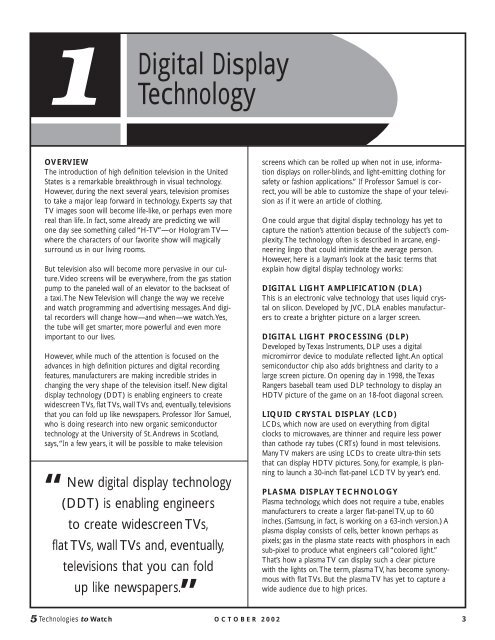1<strong>Digital</strong> <strong>Display</strong><strong>Technology</strong>OVERVIEWThe introduction of high definition television in the UnitedStates is a remarkable breakthrough in visual technology.However, during the next several years, television promisesto take a major leap forward in technology. Experts say thatTV images soon will become life-like, or perhaps even morereal than life. In fact, some already are predicting we willone day see something called “H-TV”—or Hologram TV—where the characters of our favorite show will magicallysurround us in our living rooms.But television also will become more pervasive in our culture.Videoscreens will be everywhere, from the gas stationpump to the paneled wall of an elevator to the backseat ofa taxi.The New Television will change the way we receiveand watch programming and advertising messages.And digitalrecorders will change how—and when—we watch.Yes,the tube will get smarter, more powerful and even moreimportant to our lives.However, while much of the attention is focused on theadvances in high definition pictures and digital recordingfeatures, manufacturers are making incredible strides inchanging the very shape of the television itself. New digitaldisplay technology (DDT) is enabling engineers to createwidescreen TVs, flat TVs, wall TVs and, eventually, televisionsthat you can fold up like newspapers. Professor Ifor Samuel,who is doing research into new organic semiconductortechnology at the University of St.Andrews in Scotland,says,“In a few years, it will be possible to make television“New digital display technology(DDT) is enabling engineersto create widescreen TVs,flat TVs, wall TVs and, eventually,televisions that you can foldup like newspapers. ”screens which can be rolled up when not in use, informationdisplays on roller-blinds, and light-emitting clothing forsafety or fashion applications.” If Professor Samuel is correct,you will be able to customize the shape of your televisionas if it were an article of clothing.One could argue that digital display technology has yet tocapture the nation’s attention because of the subject’s complexity.Thetechnology often is described in arcane, engineeringlingo that could intimidate the average person.However, here is a layman’s look at the basic terms thatexplain how digital display technology works:DIGITAL LIGHT AMPLIFICATION (DLA)This is an electronic valve technology that uses liquid crystalon silicon. Developed by JVC, DLA enables manufacturersto create a brighter picture on a larger screen.DIGITAL LIGHT PROCESSING (DLP)Developed by Texas Instruments, DLP uses a digitalmicromirror device to modulate reflected light.An opticalsemiconductor chip also adds brightness and clarity to alarge screen picture. On opening day in 1998, the TexasRangers baseball team used DLP technology to display anHDTV picture of the game on an 18-foot diagonal screen.LIQUID CRYSTAL DISPLAY (LCD)LCDs, which now are used on everything from digitalclocks to microwaves, are thinner and require less powerthan cathode ray tubes (CRTs) found in most televisions.Many TV makers are using LCDs to create ultra-thin setsthat can display HDTV pictures. Sony, for example, is planningto launch a 30-inch flat-panel LCD TV by year’s end.PLASMA DISPLAY TECHNOLOGYPlasma technology, which does not require a tube, enablesmanufacturers to create a larger flat-panel TV, up to 60inches. (Samsung, in fact, is working on a 63-inch version.) Aplasma display consists of cells, better known perhaps aspixels; gas in the plasma state reacts with phosphors in eachsub-pixel to produce what engineers call “colored light.”That’s how a plasma TV can display such a clear picturewith the lights on.The term, plasma TV, has become synonymouswith flat TVs. But the plasma TV has yet to capture awide audience due to high prices.5 Technologies to Watch OCTOBER 2002 3
“As thin as a credit card,the OEL screen producesamazingly bright colors andcrisp pictures.”ORGANIC ELECTRO-LUMINESCENT(OEL) DISPLAYSMost experts say the OEL is a few years away, but it couldhave the most potential of all new display technologies.Asthin as a credit card, the OEL screen produces amazinglybright colors and crisp pictures. Sony displayed a 13-inchOEL at a 2001 trade show, but the company acknowledgesthat it’s not ready for a consumer launch.HISTORYThe sudden advance of digital display technology is evenmore remarkable when you consider that the first consumertelevision had a 4-inch screen, a small motor with aspinning disc and a neon lamp. Introduced in 1928 by GE,Popular Mechanics called the set a “laboratory plaything.”Only four sets were ever produced.In the 1930s, RCA and DuMont introduced the “electronic”television, which broadcast 343 lines, 30 frames per second.But the concept of viewing images at home still had notcaught on with the American public, particularly since therewas little programming available. (Sound familiar?) But, likesome of today’s new TV technologies, television found ahome among early adopters in Great Britain. In 1937, 9,000sets were sold in the U.K. after the broadcast of the coronationof King George VI.Television began to generate bigger numbers in the 1940sand 1950s, but the shape of the set hardly changed at all.The average TV was a squat, unattractive console, whichhad a large tube protruding from the back. But in the late1950s, Philco started experimenting with the actual design.In 1960, the company introduced the “Continental,” a 21-inch mahogany wood cabinet that was shaped like a triangle.However, the technology had yet to catch up with thedesigners.The television, which had a specially designed“short-neck” picture tube, was a consumer’s nightmare.TheContinental’s picture constantly went out and, eventually, sodid Philco.The Ford Motor Company bought the strugglingcompany in 1962.The 1970s witnessed a re-birth of new TV designs.Panasonic introduced the “Flying Saucer” TV, which featureda bubble-like rectangle screen. In 1978, JVC launched a 7-inch set which included a fold-down screen. But it was notuntil the 1980s and 1990s that the size and shape of TVsreally started to change.Thanks to display technology,TVmakers introduced widescreen sets—and screens largeenough to fill a living room.The creative designs wereembraced quickly by the public, leading to more experimentationby set makers.Today, the high definition television is the subject of vigorousdebate in the United States. But, over the next decadeor so, HDTVs will be in every American living room.Theincreased resolution of HDTV displays was designed foroptimal viewing distance 3-times the picture height (vs. 5-7times the picture height for NTSC).The wide screen highresolution display then immerses the viewer in programming,bringing the home theater viewing experience toreality.And the picture will only get more powerful. HDTV,which now comes as large as 70-inch sets, will be displayedon flat screens that take up entire walls.With flat screendisplays the need for higher resolution becomes more pronouncedespecially with larger screen sizes, 50-inch andhigher.That places the viewer at the optimal viewing distance.Thescreen will display multiple channels, enablingfamily members to watch different shows at the same time.And televisions will come in all sizes and shapes, customizedto the needs and desires of the consumer.But how does the new display technology hit critical mass?How does it get from concept to everyday reality? Andhow quickly will it happen.THE BARRIERSThere’s no question that new display technology is finding amarket. Sales of flat TVs, for instance, are increasing rapidly.However, before we drill down to look at the potential ofDDT, let’s examine the technological and marketing barriersthat stand in its way.TECHNOLOGY:TOO GOOD FOR ITSOWN GOOD?Industry officials often say that consumers will not buy newproducts because they fear they will become obsolete in afew years. Ironically, in regards to digital display technology,the industry itself is wavering. Some companies are unsurewhether to mass produce—and promote—new DDT setsbecause they believe a better technology is just around thecorner. For instance, Sony, which just launched a $5,900 30-inch LCD flat TV, is working on a much thinner OEL display.Richard Chu, an analyst for ING Securities, told Reutersthat Sony is not banking on its current flat-screen model.“They don’t think this is the future of TV technology.This isjust a transition period,” Chu said.Yoshinori, Onoue, deputypresident of Sony’s Home Network Company, acknowledgedthat the company is not in a rush,“We debatedwhether it would be right for Sony to rush LCD and plasmamodels to market, but we wanted to put out products4 OCTOBER 2002 5 Technologies to Watch










